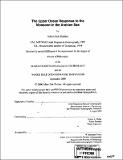| dc.contributor.advisor | Robert A. Weller. | en_US |
| dc.contributor.author | Fischer, Albert S. (Albert Sok) | en_US |
| dc.contributor.other | Woods Hole Oceanographic Institution. | en_US |
| dc.coverage.spatial | au----- | en_US |
| dc.date.accessioned | 2010-09-03T18:27:47Z | |
| dc.date.available | 2010-09-03T18:27:47Z | |
| dc.date.issued | 2000 | en_US |
| dc.identifier.uri | http://hdl.handle.net/1721.1/58365 | |
| dc.description | Thesis (Ph.D.)--Joint Program in Physical Oceanography (Massachusetts Institute of Technology, Dept. of Earth, Atmospheric, and Planetary Sciences and the Woods Hole Oceanographic Institution), 2000. | en_US |
| dc.description | Includes bibliographical references (p. 217-222). | en_US |
| dc.description.abstract | Estimation of the upper ocean heat budget from one year of observations at a moored array in the north central Arabian Sea shows a rough balance between the horizontal advection and time change in heat when the one-dimensional balance between the surface heat flux and oceanic heat content breaks down. The two major episodes of horizontal advection, during the early northeast (NE) and late southwest (SW) monsoon seasons, are both associated with the propagation of mesoscale eddies. During the NE monsoon, the heat fluxes within the mixed layer are not significantly different from zero, and the large heat flux comes from advected changes in the thermocline depth. During the SW monsoon a coastal filament exports recently upwelled water from the Omani coast to the site of the array, 600 km offshore. Altimetry shows mildly elevated levels of surface eddy kinetic energy along the Arabian coast during the SW monsoon, suggesting that such offshore transport may be an important component of the Arabian Sea heat budget. The sea surface temperature (SST) and mixed layer depth are observed to respond to high frequency (HF, diurnal to atmospheric synoptic time scales) variability in the surface heat flux and wind stress. The rectified effect of this HF forcing is investigated in a three-dimensional reduced gravity thermodynamic model of the Arabian Sea and Indian Ocean. Both the HF heat and wind forcing act locally to increase vertical mixing in the model, reducing the SST. Interactions between the local response to the surface forcing, Ekman divergences, and remotely propagated signals in the model can reverse this, generating greater SSTs under HF forcing, particularly at low latitudes. The annual mean SST, however, is lowered under HF forcing, changing the balance between the net surface heat flux (which is dependent on the SST) and the meridional heat flux in the model. A suite of experiments with one-dimensional upper ocean models with different representations of vertical mixing processes suggests that the rectified effect of the diurnal heating cycle is dependent on the model, and overstated in the formulation used in the three-dimensional model. | en_US |
| dc.description.statementofresponsibility | by Albert Sok Fischer. | en_US |
| dc.format.extent | 222 p. | en_US |
| dc.language.iso | eng | en_US |
| dc.publisher | Massachusetts Institute of Technology | en_US |
| dc.rights | M.I.T. theses are protected by
copyright. They may be viewed from this source for any purpose, but
reproduction or distribution in any format is prohibited without written
permission. See provided URL for inquiries about permission. | en_US |
| dc.rights.uri | http://dspace.mit.edu/handle/1721.1/7582 | en_US |
| dc.subject | Earth, Atmospheric, and Planetary Sciences. | en_US |
| dc.subject | Woods Hole Oceanographic Institution. | en_US |
| dc.subject | Joint Program in Physical Oceanography. | en_US |
| dc.subject.lcsh | Monsoons Arabian Sea Computer simulation | en_US |
| dc.subject.lcsh | Ocean temperature Arabian Sea Computer simulation | en_US |
| dc.subject.lcsh | Ocean-atmosphere interaction Arabian Sea Computer simulation | en_US |
| dc.subject.lcsh | Meteorology Arabian Sea Diurnal variations Computer simulation | en_US |
| dc.title | The upper ocean response to the monsoon in the Arabian Sea | en_US |
| dc.type | Thesis | en_US |
| dc.description.degree | Ph.D. | en_US |
| dc.contributor.department | Woods Hole Oceanographic Institution | en_US |
| dc.contributor.department | Joint Program in Physical Oceanography | en_US |
| dc.contributor.department | Massachusetts Institute of Technology. Department of Earth, Atmospheric, and Planetary Sciences | |
| dc.identifier.oclc | 48685243 | en_US |
